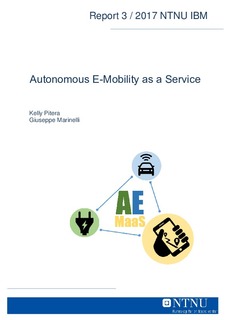| dc.description.abstract | Mobility as a Service (MaaS) is a systems-oriented approach of integration of numerous transport services into a single, seamless mobility service using a technology platform. Building on MaaS to incorporate both electric and autonomous mobility, the concept of Autonomous E-Mobility as a Service (AE-MaaS) is examined within this project as a way to improve the environmental sustainability of urban mobility. Through a series of workshops and meetings, the aim was to understand the feasibility of an AE-MaaS system, identify critical elements of AE-MaaS development, and understand how to ensure that sustainability is reached when developing AEMaaS systems. Two AE-MaaS scenarios were considered, focusing on differences in the first/last mile autonomous component of the system, one being a fixed route service, the other being an on-demand service. The scenarios were considered through different perspectives of cities and citizens, context and economics, and vehicles and MaaS technologies.
The concepts of (1) communication and data transfer within a technical framework, and (2) needs and wants of users were identified as areas where more knowledge and experience is needed in order to build a successful AE-MaaS system. Understanding the needs and wants of users is specifically important if the goal of an AE-MaaS system is to improve the sustainability of urban mobility, largely through the reduction of personal vehicle miles travelled. As environmental sustainability within an AE-MaaS system is not a guarantee, the public authority is likely to need to take an active role to secure sustainability, either by taking an active role in the development of the system, or instituting procurement policies which require and/or reward sustainability within a private system.
The demonstrations and adjacent projects discussed within the report illustrate that the technology is developing rapidly and largely accepted by the public, public authorities are interested in implementing MaaS concepts, and there are potential markets where an AE-MaaS service could motivate people to move from their personal vehicles to more sustainable mobility options. To fully demonstrate and validate an AE-MaaS system, legal acceptance of autonomous vehicles is required. At the same time AE-MaaS is dependent on the timeline of advances in autonomous technology.
The ideas developed and discussed within the AE-MaaS Pathfinder project must be narrowed down and specified for a specific need and location in order for a successful demonstration. There are still questions related to the information technology platform, travel behavior and acceptance of AE-MaaS users, and full financial feasibility of the system, which should be further explored before and within a demonstration scenario. This study was funded through the EIT’s Climate KIC Patherfinder Program. | nb_NO |
